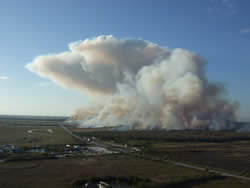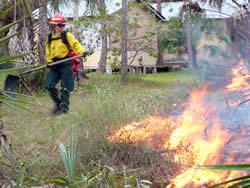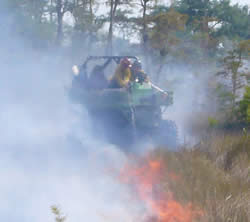Forests and Rangelands Success Story
Park Completes Second Year of Landscape-Level Fire Restoration
Big Cypress National Preserve, Florida
National Fire Plan - Fuels Reduction
2008

Anvil cloud forming over the Birdon 4 prescribed fire.

Mindy Wright works on holding and structure protection during the Concho 1 prescribed fire.

Big Cypress Fire Management staff conducted ignition operations from a swamp buggy.
Florida’s Big Cypress National Preserve is on its way to restoring the historic fire return interval on a half-million acres of fire-dependent landscape.
Burnable vegetation on the 3/4-million acre Preserve spans roughly a half-million acres, not counting the cypress strands and dome, which also may burn on a less frequent interval. Historically the Big Cypress landscape burned every 3 or 4 years, but recent decades have brought more restrictions on prescribed fire. However, approximately 100,000 acres burned in 2007 including the Big Cypress Complex wildfire. For 2008, Big Cypress Fire Management Officer John Nobles and his staff set a goal of 70,000 acres, with the intent of completing all the burnable acres in 5 years.
The vision is unique in its scope and even more ambitious in its implementation. Nowhere else in the National Park Service has fire been restored to the ecosystem on such a large scale, outside of Alaska and Yellowstone after the fires of 1988. Big Cypress leads the National Park Service in annual acres treated with prescribed fire.
Wildland-urban interface has added to the complexity at Big Cypress. Interspersed throughout the Preserve are 300 inholder camps containing approximately 1,500 structures. Firefighters took actions to protect these camps as well as campgrounds, bird nesting and panther denning areas, monitoring stations and three highly traveled road corridors.
Despite adverse weather and operational conditions, the Fire & Aviation staff completed over 56,000 acres of prescribed burns in 2008. In addition to this accomplishment, approximately 11,000 acres burned in wildfires, bringing the Preserve close to this year’s management goal.
Big Cypress’ Assistant Fire Management Officer George Sheppard credited the staff for the unit’s prescribed fire accomplishments this year: "These firefighters worked so well together … it was the true definition of a fire management team. They overcame the adversities that we confronted throughout that period." This year’s challenges included adverse weather conditions, especially on neighboring units that experienced extreme indices at times when conditions at Big Cypress remained within prescription, as well as limited availability of air resources. "If you have a smaller unit it’s a lot easier to pull that cohesion together," Sheppard continued. "It was, what can we do to help accomplish this project here?"
Already, the massive prescribed burning effort has paid off. Wildfire occurrence on the Preserve decreased dramatically in 2008 compared to 2007, the year that kick-started the drive. The decrease came despite dry conditions in southern Florida during the 2008 suppression season. In turn, suppression costs were reduced. Sheppard said, "We captured the benefits of fire, but under safer and more favorable conditions. We filled up a wall-sized dry erase board with reasons to return fire to this landscape, and now we are DOING it."
The Big Cypress Fire Management staff includes:
| Name | Position |
|---|---|
| Bill Evans | Helicopter pilot and Type 2 Firefighter |
| Mike O'Leary | Aviation Manager and Type 2 Prescribed Fire Burn Boss |
| Jay Thatcher | Engine Captain and Type 2 Prescribed Fire Burn Boss Trainee |
| Kevin Logiudice | Engine Captain and Firing Boss |
| Justin Turnbo | Rx Fire Technician and Firing Boss |
| Mindy Wright | Fire Effects Monitor and GIS Specialist |
| Shawn Shook | Assistant Engine Captain |
| Ron Pevny | Assistant Engine Captain/Fuels Tech and Type 2 Prescribed Fire Burn Boss |
| Bela Harrington | Type 1 Firefighter / Fuels Tech and Type 2 Prescribed Fire Burn Boss |
| Chris Richards | Type 1 Firefighter and Radio Operator |
| Adam Kunce | Type 1 Firefighter |
| Cynthia Hamm | Fire Program Management Assistant |
Contact: George Sheppard, Assistant Fire Management Officer, (239) 695-9280 x103.